Even though almost everyone I know laughs at my over-stocked kitchen cupboard, I have always known that really its supplies were barely adequate. But I had no idea just how many gaps I had in my larder until I started working with Magnus Nilssen’s Fäviken cookbook. Was it really possible that not only did I have no cured egg yolk, but actually had no idea how to obtain one? It seemed absurd that such a simple item could turn out to be the elusive ingredient in a recipe involving two different kinds of lichen, but there it was. Nilsson even neglects to tell us how to prepare the yolk, a strange omission in a book that does (for example) tell us how to chop, hollow out and burn the interior of a spruce trunk in order to mature some vinegar for a year (p159). Luckily there were lots of other mentors on the internet, two kinds of egg in my fridge, and plenty of salt and sugar in the aforementioned larder. All that was needed was a bit of patience while the process unfolded over the next few weeks.
I decided to record the progress of my yolks day by day, as I find it helpful to know what things I’m working on might look like both during and after the procedure. Also, the yellow globes of yolk really are quite beautiful lying in their nest of salt and sugar. This is a diary of their progress towards becoming an essential new storecupboard-staple condiment. In real life, you would be able to bury the yolks and leave them alone in their curing mix until the cheesecloth stage – unless, like me, you can’t resist seeing what’s happening.
 Day 1
Day 1
Decide how many egg yolks you want to cure. Make a 50/50 mix of fine salt and sugar, enough to surround the egg yolks in your chosen container. Separate the yolks from the whites, making the yolks as clean as possible without breaking them. You will have to discard any that do break, so be careful. Place the yolks on a layer of salt and sugar mix, cover with some more, and put the container in the fridge. Some people advise covering, others don’t. Since a core part of the process is drying I don’t think it matters – but if you are at all worried about contamination from anything else in your fridge, cover them.
Day 2

 yolks have already started to firm up! They look a richer orange, and are holding a definite shape. It is easy to touch them without fear of breaking them, so I can gently ruffle up the now damp -even wet – salt/sugar and turn them over. I decide to add some more salt/sugar to give the yolks a more complete covering. Then back into the fridge they go.
yolks have already started to firm up! They look a richer orange, and are holding a definite shape. It is easy to touch them without fear of breaking them, so I can gently ruffle up the now damp -even wet – salt/sugar and turn them over. I decide to add some more salt/sugar to give the yolks a more complete covering. Then back into the fridge they go.
Day 3

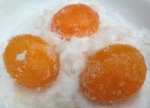 The drying continues relative to the original size of the yolk, so it is easy to see which is the duck as it is visibly larger. The effect I saw yesterday also seems consistent: the surface facing down into the cure retains the lovely curve of the fresh yolk (picture right), while the top (facing up) flattens over the course of 24 hours (picture left). I turn them again, hoping to influence the final shape through daily flipping, re-bury them, and pop them back in the fridge
The drying continues relative to the original size of the yolk, so it is easy to see which is the duck as it is visibly larger. The effect I saw yesterday also seems consistent: the surface facing down into the cure retains the lovely curve of the fresh yolk (picture right), while the top (facing up) flattens over the course of 24 hours (picture left). I turn them again, hoping to influence the final shape through daily flipping, re-bury them, and pop them back in the fridge
Day 4
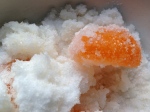
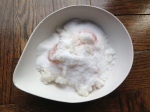 Yesterday’s shaping theory has been proved wrong: today the yolks are exactly the same shape as yesterday. At least this means that for now, there is still one curved side. They are stiffer than they were yesterday, so it seems as though there is a good chance that they will retain this shape. I think I’ll leave them alone for a few days at a stretch, now, and see how they look next week.
Yesterday’s shaping theory has been proved wrong: today the yolks are exactly the same shape as yesterday. At least this means that for now, there is still one curved side. They are stiffer than they were yesterday, so it seems as though there is a good chance that they will retain this shape. I think I’ll leave them alone for a few days at a stretch, now, and see how they look next week.
Day 10
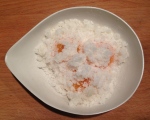
 I’ve managed to resist disturbing my yolks for almost a week. It’s definitely time to see what they’ve been up to.
I’ve managed to resist disturbing my yolks for almost a week. It’s definitely time to see what they’ve been up to.
Left undisturbed for a respectable interval the salt and sugar mix has set much more firmly – as hard as a rock in some places. I dug the yolks out quite cautiously, with the help of a blunt-edged teaspoon. Of course, after more than a of week dry-curing the yolks are now so firm that they are almost hard – certainly tough enough to withstand some pressure, so I needn’t have worried.
The main point of interest (beyond the fact that they are nearly ready for the second stage) is that the flatter side has now become concave, and those edges are noticeably paler than the centre, which is still a strong orangey-yellow.
I’ve turned them once again and re-buried them for their final few days in the cure.
Day 14

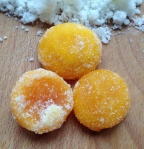 When I take the yolks out and brush them off I can still see a little bit of stickiness in the very middle. So, although I’d originally thought of taking them out of the salt and sugar today, I reckon a little more time won’t do them any harm. In fact, one last weekend in their briny bed might do them some good. I’ll rescue them in a few days’ time.
When I take the yolks out and brush them off I can still see a little bit of stickiness in the very middle. So, although I’d originally thought of taking them out of the salt and sugar today, I reckon a little more time won’t do them any harm. In fact, one last weekend in their briny bed might do them some good. I’ll rescue them in a few days’ time.
Day 17
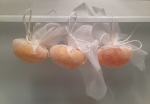
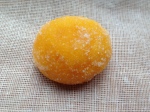 The yolks have entered their final phase – out of the cure and into the muslin. I don’t have one of those cheffy meat cupboards (shocking omission, to be remedied in my next kitchen) so they are now hanging at the back of the fridge. This is probably a little colder than the ideal, but I’m sure they will dry out nicely. They look so good hanging there it’s going to be very hard to keep my hands off them for the minimum of two weeks they seem to need…
The yolks have entered their final phase – out of the cure and into the muslin. I don’t have one of those cheffy meat cupboards (shocking omission, to be remedied in my next kitchen) so they are now hanging at the back of the fridge. This is probably a little colder than the ideal, but I’m sure they will dry out nicely. They look so good hanging there it’s going to be very hard to keep my hands off them for the minimum of two weeks they seem to need…
Day 30

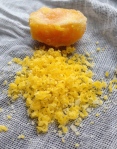 They are ready. They tear apart with some effort, and grate easily into golden curls that are delicious sprinkled on salad or used in larger quantities on pasta (think of it as a drier way of approaching carbonara – or up the cream). I have to say after this long wait that I think the end result of 50/50 salt/sugar makes something too sweet. You might prefer it that way, and some like to use more sugar, but if you are after something super-savoury (like me) I’d go for 100% salt, or 75/25. But do make some. You won’t regret finding this new staple – it might take a bit of time, but almost no effort, and the result is a gastronomic treat.
They are ready. They tear apart with some effort, and grate easily into golden curls that are delicious sprinkled on salad or used in larger quantities on pasta (think of it as a drier way of approaching carbonara – or up the cream). I have to say after this long wait that I think the end result of 50/50 salt/sugar makes something too sweet. You might prefer it that way, and some like to use more sugar, but if you are after something super-savoury (like me) I’d go for 100% salt, or 75/25. But do make some. You won’t regret finding this new staple – it might take a bit of time, but almost no effort, and the result is a gastronomic treat.
You dont have to wait so long when making them OR to use them. I cured mine (in pink Himalayan salt only, no sugar) for 6 days. Day 7, I put them on a cookie cooling rack and slipped them into the oven for 90 minutes at 175 degrees. I pulled them out and let them come to room temp on the counter and then put them in a covered Pyrex baking dish and put them back in the fridge. Ive been told they will keep at least 3 weeks this way and probably more. I used two (grated) over a very nice beef mince patty today and it was wonderful!!! Im dairy-free and these are a game changer for me. Will be a normal part of my carnivore pantry from here on out. Making Prawns in Salted-egg “batter” for dinner tonight. YUM!!!
LikeLike
[…] Source ( 1 , 2 […]
LikeLike
[…] the way, in this post from Silphium Food you can learn, with pictures, another way of curing the egg yolk in a 30 days […]
LikeLike
Hey there, very nice instructions and detailed pictures. I can’t wait to try this out myself. I have one question though: Can I also just keep the yolks in the salt for, let’s say, three weeks, rinse them and eat them afterwards? Do I really need do take them out and dry them once more in muslin? Why not letting them cure in the salt mixture until ready? And how do you see they’re ready? Or is this just personal experience?
So many questions, sorry 😀
LikeLike
You could certainly eat them without drying them further, they will just be softer at that stage so I don’t think you could grate them.
LikeLike
[…] are some fun ideas including DIY herb salt and salt cured duck egg yolks. (I have actually tried salt cured yolks, after hearing that it was a surprisingly good dairy-free substitute for Parmesan. Turns out is […]
LikeLike
Is the cured yolk oily? I took the route of oven drying my eggs in a 200F oven with a fan on. This is my first try at curing eggs. I think next time I’ll try a longer 75/25 salt/sugar ratio for a longer period of time, and definitely try hanging in the fridge to dry them.
LikeLike
The ones I have made are never oily, partly because they aren’t heated at all. I think even 200F would warm them up enough to make a difference to the composition.
LikeLike
[…] a few days they will be so solidified and can be grated onto dishes with a microplane. In fact Jane Levi gives a progress diary on the condition of her egg yolks, which take a month to reach […]
LikeLike
Just to add. This batchJust to add, this batch I did 75-25 mix salt-sugar.
LikeLike
I did 4 yolks last year. 50-50 mix. I rinsed them since I read it elsewhere. I just dried them off and hanged them in a gauze (practically the same as a muslin) and they turned out fine. I believe that today is the last curing day off my new batch. Ten I will hang them and hopefully they will turn out fine. This time I will not rinse them though! I will let you know If I remember after the drying process.
LikeLike
Great to know – if they dry well after rinsing you’re right, there is no reason they shouldn’t be fine. It’ll be really interesting to hear what you think of the difference. Also I’d love to hear what you are doing with them all. You clearly have lots of ideas for eating them as you are making them so regularly!
LikeLike
The first batch were a sample just for fun. I ran over this cured yolk at youtube and I liked the idea. When I tried to find the process through internet it wasn’t that much of options (this is where you came in the picture :)). Like previous comments here and on different blogs with the “recipe” indicates that it’s a good and more exciting alternative to for example parmesan.
Im not sure what I will use it all for. Its good it doesn’t get bad right? I suppose I will use it for a starter at work and of course on staff food. Im also interested to try the “shortcut” version like a previous comment indicates. Just because its a “shortcut”. Sometimes Im impatient.
And I will see if Im more happy with the 75-50 mix. I found thw 50-50 little bit too sweet. But as we say in Sweden; “Smaken är som baken”.
LikeLike
They do keep, but they also keep on getting harder so they become a bit more difficult to cut or grate over a long period of time. But they still taste good!
I’m with you on 50/50 being a bit too sweet – I have high hopes for your 75/25 mix. It’s all a matter of taste.
LikeLike
A rinse in cider vinegar will definitely help at that stage. It really adds a complex depth. I also smoke mine for about twenty minutes with Apple wood before the final drying process.
LikeLike
Sounds fantastic – I’ll definitely try this with my cold smoker next time I make some!
LikeLike
Hi,
I really want to try that! when finished and ready to be used, do you store them in salt? or do you rinse them and store them in plastic containerrs in the fridge?
lately a Chef said, he just cures them for like 12 to 24 hours and then just dehydrates them for a while. Have you heard of / tried this method before?
Have a happy new year!
Mathias (from Germany)
LikeLike
Hi Mathias. I take them out of the salt and store them wrapped in muslin in the fridge, though a friend of mine just leaves them lying around in the kitchen. You could store them in a plastic box, but do not rinse them, the last thing you want to do is get them wet. they are preserved by the salting process but if you introduce moisture they could go bad.
I don’t have a dehydrated but I can imagibne that the technique you describe there would work well – the result would probably be less salty too.
I hope it goes well – enjoy!
LikeLike
I used 1 3/4 c kosher salt and 1 1/4 c granulated sugar for 5 days in the fridge and then 2 hours in a warm oven (about 200 degreees) and the consistency was perfect, but they were WAY too salty! do I change the kind of salt I’m using or the ratio of salt to sugar?
LikeLike
Hi there, I like your oven shortcut, that is a handy hint for those of us who get tired of waiting! About the saltiness, I think it is a matter of taste and that salt is pretty much salt for this purpose – so I suggest you increase the proportion of sugar until you find the balance that is right for you. Good luck!
LikeLike
ok I cured my eggs for three weeks, then hung them in my walk in for two weeks. they have now gained a lot of moisture and I think they are ruined; so my question is what is a muslin and what can I do to the next batch to keep them dry?
LikeLike
Hi there – that sounds very annoying after waiting so long for them to be ready. Can you tell me a bit more about what they are like and why you think they are ruined? Are they moldy or slimy at all? If so, I think you are right and will have to start again, unfortunately.
I am very surprised they would gain a lot of moisture, I have not known that to happen before – but perhaps a professional walk-in is much more damp than a domestic fridge (which is what I have). Some friends of mine keep the yolks at room temperature once they are dried, and they do need a dryer environment, so perhaps that would work better for you.
The other point is that wherever you keep them, I think you are better off keeping the air circulating – I wouldn’t recommend sealing them up in plastic wrap or anything like that. Muslin is like a fine cotton gauze, so while it protects them it lets them continue to breathe.
Finally, the balance of salt to sugar in your curing mix might make a difference – the more salt, the drier they will be, so a shorter curing time will matter less. What proportions did you use?
I’d be happy to have a bit more info to try to get to the bottom of the problem and to make it a success next time!
LikeLike
Started mine last night with a ration of 1 cup salt to 1/4 cup sugar. Can’t wait!
LikeLike
Sounds great – let me know how it goes!
LikeLiked by 1 person
What do the cured eggs taste like?
LikeLike
Oh, I find describing flavours quite difficult – our vocabulary is so limited, and we all have our own flavour maps in our brains, but here goes! I am not at home so I don’t have one to eat as I am doing this, so this is from memory… One of the main things is that they are very savoury, giving an intense umami feel. They are also quite intensely eggy: a strong, nutty flavour of the yolk. Then, of course, they are a bit salty-sweet, which varies depending on what proportion you used in your mixture. I think I have to ask you to make some and tell me what you think they taste like!
LikeLike
Oh wow, they sound great – you had me at umami and savoury 🙂 I am big on cured and fermented foods right now and am going to give these a try – thank you!
LikeLike
Great – and if you still remember after you’ve been through the process and can take a break from the deliciousness then do check back in and tell me what you think!
LikeLike
Will do! This actually reminds me a lot of bottarga, and some of the ways you suggested to use it are similar as well.
LikeLike
Yes, they are similar uses, though the underlying flavour is definitely egg, not fish. I have also just remembered that a Chinese friend told me she uses them in congee and soups as well as other savoury dishes – I will try to gather up and try out some more ideas, and post something, maybe by the time your first batch is ready.
LikeLike
Thank you! 🙂
LikeLike
So how is it actually safe to eat?
LikeLike
I’m not sure what you mean by ‘safe’. They are preserved with the salt and by drying, like lots of products we eat every day, so if you follow a safe process they are safe for consumption. If you mean safe as in not overwhelming, one good simple way is grated over pasta with a bit of olive oil and chopped parsley, or grated over a salad – but the best thing to do is to taste them and decide for yourself what might work! (And sorry for the slow reply – a few messages got stuck when I thought I had replied on a remote device)
LikeLike
How long do they last?
LikeLike
I’ve got some that are a year old, though I think it is better to use them within a month or so, and make some more as an ongoing supply. The get more and more dry, and so adder and adder the older they get, so they do become quite difficult to cut or grate. (So sorry for the delayed reply – I had a problem with my remote access and it got stuck!)
LikeLike
im currently going through an apprenticeship into becoming a chef and im looking forward to trying this out as a little play around/ experiment trying out new and not to popular techniques!
LikeLike
Hi Jade, lucky you starting on that apprenticeship. I bumped into a friend the other day who said she’d tried them, as they are similar to a Chinese ingredient she hadn’t known how to recreate – and now she makes them all the time. She puts them in soups and into rice dishes, amongst other things. Can’t wait to hear what you do with yours!
LikeLike
Sounds terrific!
LikeLike
Does this blog have a Facebook page?
LikeLike
No, it doesn’t – but perhaps it should… I am finishing a huge piece of writing at the moment, and once that is done I will perhaps re-emerge out into the world again!
LikeLike
Thank you!
LikeLike
I’m going to do this! How do you store them after they are done?
LikeLike
Hi Robyn, I’m glad you’re going to give it a go, you won’t regret it! They keep well, because they are cured and they just keep drying out. You can keep them anywhere cool and dry – I keep mine in the fridge but I know other (maybe less fastidious) people who just leave them out somewhere cool in the kitchen or pantry. Apply the same logic as keeping a hard cheese and you’ll be fine. Let me know how it goes and which dishes you like them best in!
LikeLike
FYI: Have you noticed the dates on the posts? It’s the 12th day of January.
LikeLike
It’s hard to believe I wrote about that a whole year ago. I need to think of a new experiment to kick off 2014.
LikeLike
I started day 1 this morning, saw a sidebar in Bon Appetit about grating the cured and aged yolks. Thank you for your detailed instructions. Now off to find out how to candy more yolks!
LikeLike
I’m so glad it’s useful. Let me know how yours turn out!
LikeLike
Nice instructions and easy to follow pics of progress. Was reading about these in a magaizine as of recent. Will try your recipie and let you know the outcome….thanks.
LikeLike
Thanks Jack! I really look forward to hearing how it goes.
Jane
LikeLike